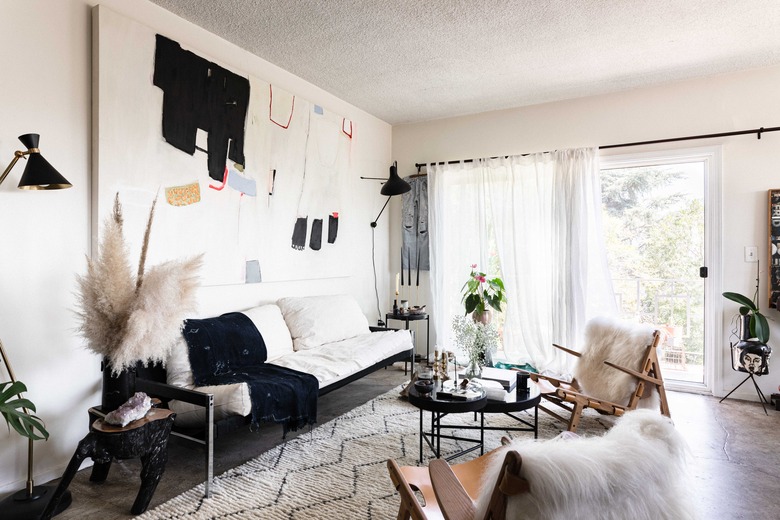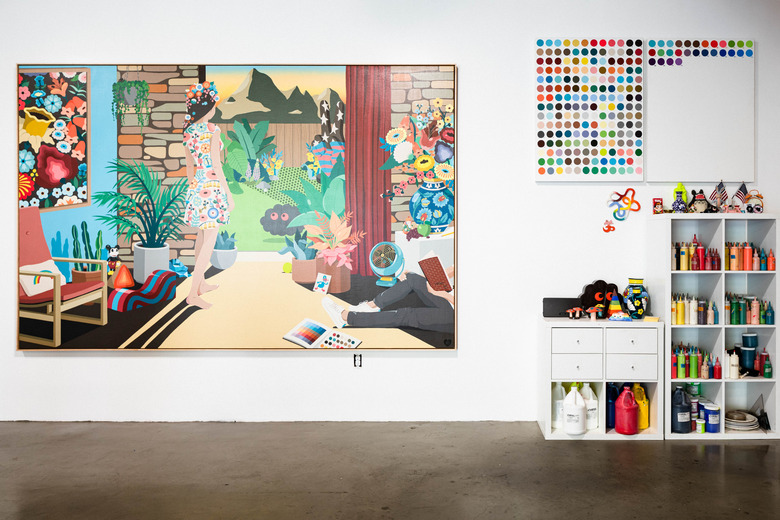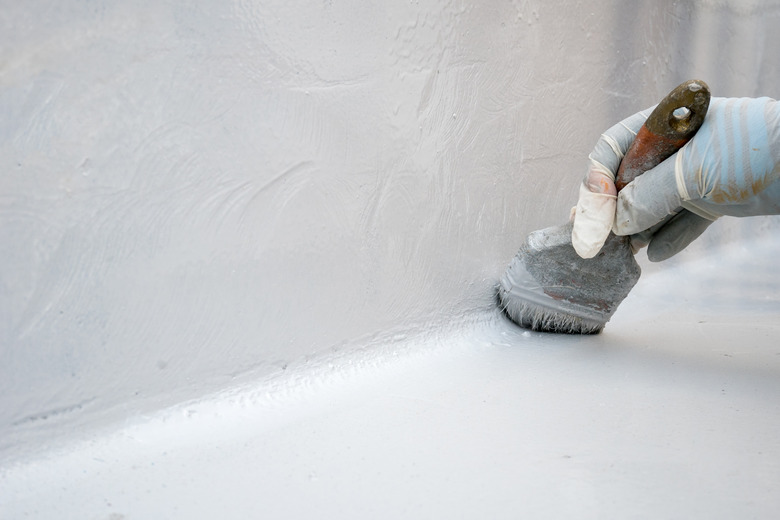Concrete Floor Paint: What You Should Know
A painted concrete floor can look stylish and colorful, especially if you stencil a design — and because it's concrete, it's more durable than almost any other type of floor. You need concrete paint to do the job, though, because wall paint, interior enamel and exterior paint are all unsuitable. They can't stand up to foot traffic or moisture, and they don't adhere well to the filmy, smooth surface of concrete.
All Garage Floors separates concrete paint into two broad categories: acrylic latex specifically formulated for concrete floors and one-part epoxy concrete floor paint. Neither is as durable as a two-part epoxy coating, but this isn't technically a paint, and it's more troublesome to apply. Of course, you can always stain the concrete and apply a polyurethane, acrylic or epoxy sealer, but none of these will provide the opaque and high-sheen finish that paint does.
Choosing the Best Concrete Floor Paint
Choosing the Best Concrete Floor Paint
When it comes to price, there isn't much difference between acrylic and epoxy concrete paint, and for the DIY painter, there isn't much difference in application methods either. When it comes to durability, however, epoxy is the clear winner, and it's the better choice for a garage floor and high-traffic basement floors that get a lot of abuse. Epoxy paint is more chemical-resistant and protects better against mildew, stains, scuff marks and chipping. Plus, it won't peel under hot tires and it leaves a shinier surface.
If it's an epoxy paint you're after, Kilz 1-Part Epoxy Concrete and Garage Floor Paint is one of the top brands recommended by All Garage Floors, and it's also on the A list of concrete floor paints found on Best Reviews Guide. Kilz also makes a less-expensive acrylic latex porch and floor enamel that can also be used on concrete, but you have to apply a primer first, so it ends up costing more. It's the better choice, however, if you're looking for a low-luster finish.
If you want a color other than gray or white, you have a narrower range of choices. Kilz, Rust-Oleum, Behr and Valspar all make tintable acrylic latex floor paint that is suitable for concrete, but not all are deep base, so you may have to do some shopping if you're looking for a rich, dark finish. The best concrete paint overall, and the one that tops most review lists, is Drylock Concrete Floor Paint, which at almost $84 per gallon isn't cheap, but it's a super-durable, water-based latex product that's easy to use — and it's tintable. Premixed colors range from Persian red to bamboo, and it comes in a base that can be tinted spruce green, deep charcoal or caramel.
Don't Forget Primer and Sealer
Don't Forget Primer and Sealer
Before you apply any paint to concrete, you must first apply a primer unless you're using a paint that includes a primer. One reason for the primer is to seal the concrete and another is to provide an adhesive surface for the paint. Be sure to choose a primer that is designed for use on concrete and is compatible with the paint you're going to use.
When using acrylic latex paint, applying a top coat of clear sealant is a good idea to help your beautiful new floor stay that way longer. You can also apply a top coat to an epoxy-painted floor if you want to cut the sheen or prevent slipping by adding an anti-skid additive. You can also add skid-proofing to the final paint coat if you prefer.
Is My Floor a Good Candidate for Painting?
Is My Floor a Good Candidate for Painting?
You can paint any concrete floor that is clean and dry. New concrete needs about a month to cure and release residual moisture, and when you think it's ready, you should test it. Tape a piece of plastic sheeting to the concrete, leave it overnight and check for water beading on the underside of the plastic. If you find any, wait a little longer before painting.
It's important to patch cracks and holes, and any patching you have to do has to be leveled meticulously before you paint or the repairs will show. If you have to make a lot of repairs, you might consider resurfacing the entire floor as an alternative to sanding and grinding down the patches. Give the resurfacing compound a week to cure, and perform a moisture test before you paint.
How to Paint a Concrete Floor
How to Paint a Concrete Floor
Things Needed
-
Trisodium phosphate
-
Etching compound
-
Masking tape
-
Primer (optional)
-
Clear sealant
-
Rubber gloves
-
Goggles
-
Protective clothing
-
Watering can
-
Scrub brush
-
Power washer or garden hose
-
Wet/dry vacuum
-
Paint roller
-
Paintbrush
-
Damp cloth
1. Clean the Concrete Slab
Wash the concrete with a strong solution (1/2 cup per 2 gallons of water) of trisodium phosphate (TSP) or TSP substitute and water to remove oil spots, grease and grime that can prevent adhesion. TSP is a degreaser and is more effective for cleaning than plain soap and water, but it's caustic, so wear rubber gloves and goggles while using it. If you're working outdoors, you may prefer to power wash with a liquid TSP substitute.
2. Etch the Surface if It Is Super Smooth
Concrete floor paint doesn't adhere well to a smooth, dense surface. Run your hand along the concrete, and if it feels smoother than 150-grit sandpaper, etching is recommended.
Most etching compounds contain muriatic acid or phosphoric acid, so you need gloves, goggles and protective clothing. Mix the product you purchase with water according to the directions, spread it with a watering can and work it in with a scrub brush. Rinse well with a power washer or garden hose or by pouring water on the floor with a bucket. Vacuum excess water with a wet/dry vacuum and let the concrete dry for 24 hours.
It's a good idea to mask off obstructions such as posts and cabinets with masking tape to avoid getting any paint on them.
3. Check the Temperature
Apply the paint on a day when the temperature is between 50 and 80 degrees Fahrenheit. If the temperature is too cold, concrete floor paint won't dry or cure quickly enough, and if it's too warm, it will dry too quickly, and it may form bubbles or crack. If painting outdoors, wait for a dry day with no rain in the forecast.
4. Apply a Primer (Optional)
You don't need a primer with all concrete floor paints, but it never hurts to use one. You do need a primer with most acrylic latex concrete floor paint products. If you're using one, apply the primer with a long-handled paint roller. Let the primer dry for the time specified on the container.
5. Paint the First Coat
Spread the paint over the bulk of the floor with a long-handled roller using a paintbrush to get into corners, around obstructions and around the floor perimeter. Don't expect full coverage on the first coat. It's better to apply two or three thin coats than one heavy one. Let the paint dry overnight or longer depending on the humidity and temperature.
6. Apply the Second Coat
Vacuum the floor and tack it with a damp cloth. Apply the second coat in the same way you applied the first one.
7. Give the Floor an Optional Top Coat
If you decide you use one, apply a sealer after the top coat has dried and cured, which may take from one or two days to a week. Check the curing time on the product container label.


